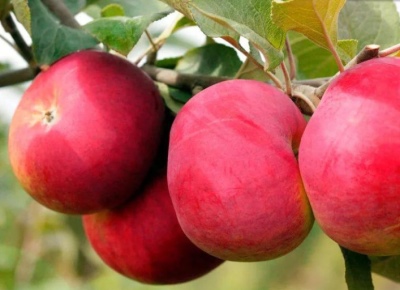
- Authors: Selection station in Sverdlovsk, author - L.A. Kotov
- Taste: sweet, with a slight refreshing sourness
- Scent: pronounced
- Fruit weight, g: 120-140
- Fruit size: average
- Yield: high
- Frequency of fruiting: annual
- Ripening terms: late summer
- Removable maturity: end of August
- Keeping quality: 1.5 months
The cheerful name of the Rosochka apple tree should not be misleading. In fact, this is a very serious culture, and the attitude towards it should also be as serious as possible. It is necessary to understand the peculiarities of plant cultivation and find out what result can be expected.
Breeding history of the variety
The apple tree Rozochka was created at the Sverdlovsk breeding station. The main work on this plant was carried out by L.A. Kotov. The varieties Orlovim and Serebryanoye Kopytse served as the source for hybridization. Now the plant continues to be used for further breeding work already as a basis for the development of new crops.
Description of the variety
The height of the Rosochka apple tree reaches 2 m. The crown is rounded, has a moderate density. It is characterized by matte green leaves. And also typical are pale pinkish flowers, densely showered with branches. The external beauty of the plant is undeniable.
Features, pros and cons
The growth of culture is moderately large. It is not as difficult to grow as the dwarf varieties, but there are no problems with harvesting from a tall trunk. The fruit will be quite large and tasty. Fruit picking will be very stable. They also note a decent resistance to bad weather, however, the Rosochka apple tree very often gets sick and is regularly visited by pests.
Ripening and fruiting
The plant is self-fertile. For a normal harvest, it is imperative to plant any other trees with a similar growing season. According to the timing of the formation of fruits, it is referred to as late summer apple trees. Fruit picking is usually possible at the end of August. The collection takes place stably, every year, unless the weather or violation of agricultural standards is very harmful.
Yield
The plant is positioned as a completely prolific crop. Sometimes they claim yields are slightly above average. Various sources speak about harvesting 70-110 kg of apples per season. It is appropriate to assume that this is due to the difference in climatic conditions, soil characteristics and nuances of agricultural technology. One way or another, you can confidently use the culture for commercial purposes.
Fruits and their taste
The average weight of apples is 80 g. Their largest recorded weight is 120-140 g. Fruits are colored in bright yellow or golden-yellow tone, the cover color is a continuous crimson blush. The rind is firm but thin and soft. Other details:
sweet taste;
refreshing sour note that does not overshadow the main taste;
powerful aroma;
guaranteed keeping quality up to 45 days;
creamy white juicy pulp;
assessment of the tasting examination - 4.5 points;
shedding apples from branches ahead of schedule is almost impossible.

Growing features
Lighted places are preferable for Rosochka. Some shading is allowed, but nothing more. The variety needs well-moistened neutral loamy soils with a noticeable amount of nutrients. Active watering is required only on hot days.Growing prospects in cities are pretty good, if only the ecological situation is kept minimally within the bounds of decency.
Do not use areas where soil water approaches closer than 2 m. Landing on a hill or drainage helps to avoid constant flooding. When planting in spring, the planting holes must be prepared in 14 days. If it is decided to plant a Rosette in the fall, then the preparation of the pits should be completed in 6 months. Drainage should also be provided initially.



Top dressing
The variety's responsiveness to fertilization is very high. Their composition and concentration are usually selected individually according to need. Organic matter is used in spring and summer. With the approach of autumn, there is a need for phosphorus-potassium mixtures. Exceeding the standard dosage is highly undesirable.

Frost resistance
The rosette can be safely planted even in relatively cold places. It can also tolerate frosts returning in spring. However, at least minimal shelter measures are still required. The 4th zone for winter hardiness is declared.

Diseases and pests
The variety is susceptible to infection:
rust;
scab (according to other sources, resistance to it has been achieved);
powdery mildew.
Of insects, the threat to planting is:
aphid;
honeydew;
moth;
spider mite.

The apple tree is a popular fruit crop among gardeners. It can be found in many summer cottages. But at the same time, such trees are often affected by various diseases. It is very important to recognize the disease in time and carry out the necessary procedures for a speedy recovery. Otherwise, the fruits will be spoiled, and the tree itself may die altogether.












































































